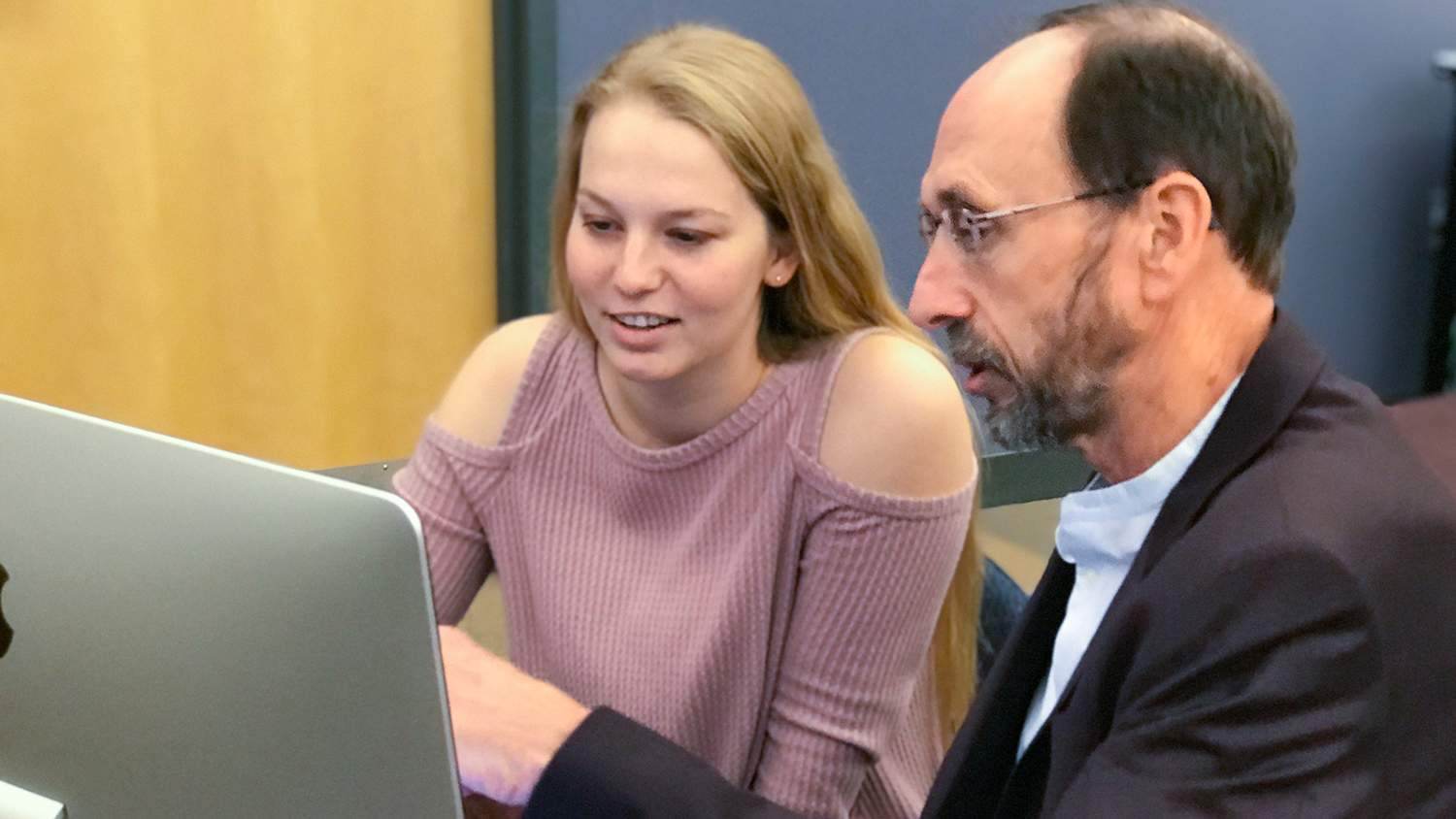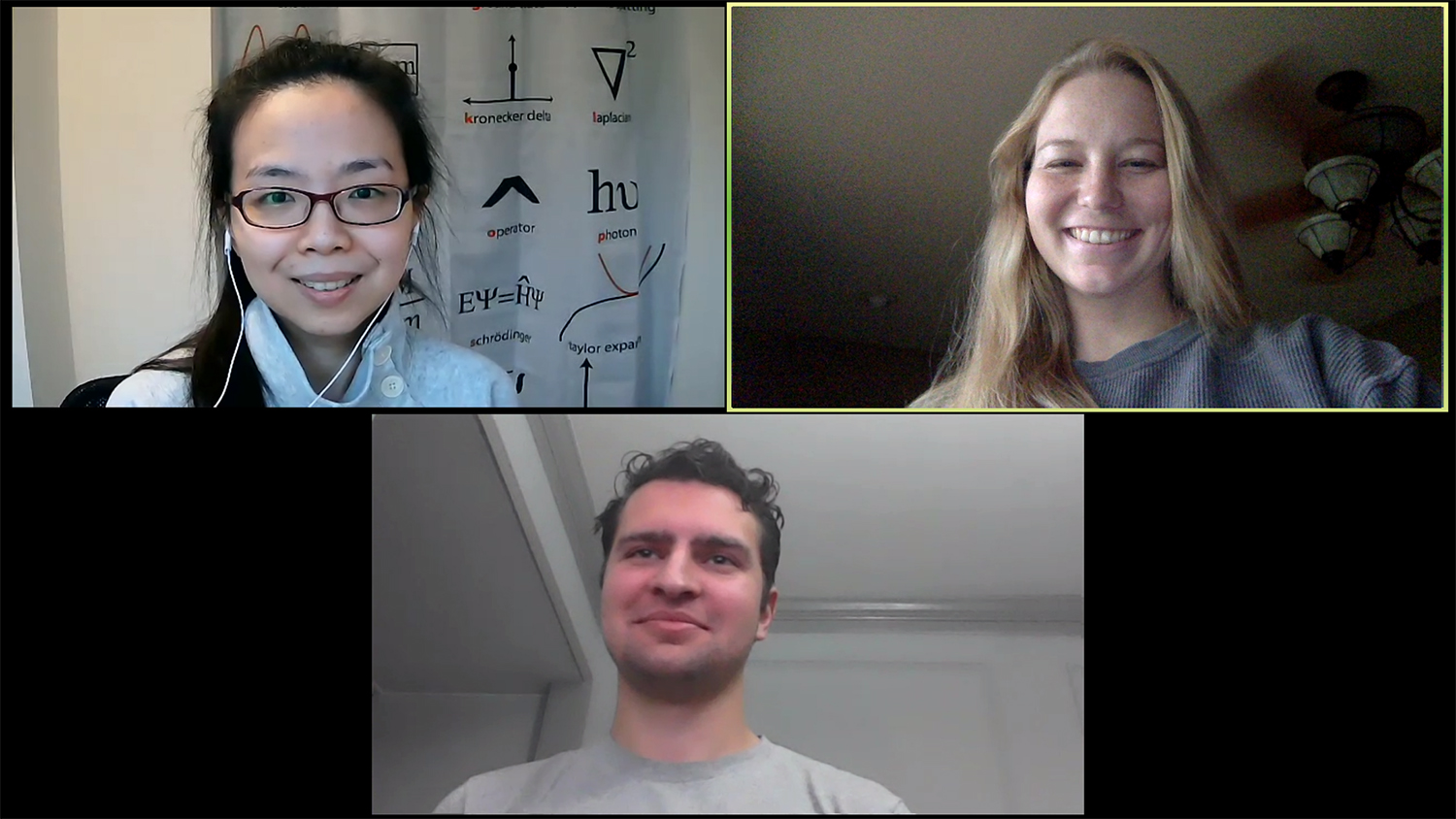The right chemistry: Furman undergrad makes a name for herself in computational field
How do you top off an undergraduate career that earned two of the nation’s top awards?
If you’re Ariel Gale ’20, who graduated with a degree in chemistry, you spend your last semester, during a pandemic, working hard to publish a paper in an international peer-reviewed journal, adding your expertise to the body of knowledge so you and other scientists can build on the work.
And then you do it again, this time as first author, an honor given to the researcher who did most of the heavy lifting on the work being published.
And then you do it again, with your research group in computational chemistry, led by Professor George Shields. And … then you publish a fourth paper, again as first author.
How did it feel? “It was awesome,” said Gale, who now is a doctoral student at Emory University. “It was definitely the hardest and most rewarding thing I did as an undergrad.”

Ariel Gale ’20 meets with George Shields, chemistry professor, in the computational chemistry lab. Gale was a Goldwater and Beckman scholar and went on to a PhD program at Emory.
Gale, a Goldwater Scholar and a Beckman Scholar, each award given to outstanding undergraduate science majors, started working in Shields’ lab the summer before her junior year helping explore the beginning of life on Earth.
Their fundamental question was how proteins first appeared. Proteins are the “building blocks of life.” Made up of long chains of amino acids called polypeptides, proteins are present in every living thing. But where did proteins come from?
Shield’s lab specializes in computational chemistry, basically creating computer models of chemical reactions to test various hypotheses. Gale and other students were trying to determine if amino acids could come together in the “prebiotic earth,” before all the ingredients for life existed in abundance, to create proteins, which might later form into cells and, eventually, living organisms.
Shields was talking with his research group one day and, he says, “I had this idea that maybe amino acids helped form small aerosols. I wondered if amino acids could form a small peptide in these aerosol particles.”
Shields asked his chemistry colleague Greg Springsteen, “who does this origins-of-life work,” if amino acids in an aerosol cloud “might be oriented so that they could actually spontaneously form the peptide bond.
The notion, if proved, could establish a new way of understanding how life on earth began.
“If we can establish a specific property, that could be a whole new way to understand the atmosphere, both in prebiotic chemistry terms and for global warming and climate change, which is something the group historically has been interested in,” Gale says.
There’s also a chance that understanding this new chemistry could lead to understanding other interactions. “Once you analyze (the data), sometimes you can find the properties of a system,” Gale says. “That’s what is really exciting, when you have something specific that happens that can be generalized.”
Over two and a half years, Gale, her fellow chemistry classmate at the time, Tyler Ball ’20 (now a Furman graduate student in chemistry), and postdoc Tuguldur Odbadrakh worked out how to conduct simulations, then used high-performance computers to model the reactions. The papers – they’re all authors – explains how they did it, and, to a certain extent, that it’s possible.
The process led Gale to realize that she found her niche, and that her Furman experience was also foundational to her career.
“I was really lucky that I stumbled into a group that I enjoyed and that really fits my intellectual pursuits,” Gale said in a pre-pandemic interview in February 2020. “I realized through my work in this lab that I enjoy physical and theoretical chemistry and the idea of fundamental research and basic science is really interesting to me.”
Shields says Gale’s creative input to the research set her apart from most students he’s taught.
“I’d say, ‘I’m not quite sure how we should do this particular calculation.’ And she’d say, ‘Huh. Well, why don’t we do such-and-such?’ And I’d think, ‘Yeah, that’s a great idea!”
By her second summer in the lab, he says Gale “had all sorts of ideas about ways to do things.
In fact, I had her working on four different projects.”
Gale credits Shields, who made her feel like an equal in conversations with the group about their work, which would sometimes go on for several hours.
“He would ask, ‘What do you think we should do?’ Then he genuinely stopped and listened to my answer. When I realized that he was looking to me to decide what we were going to do – to see that he had that faith in me – encouraged me to take more ownership in my work and to really see myself as someone who was doing my own work instead of work for Dr. Shields,” Gale says. “To have him see me and the rest of the group as competent peers kind of has a self-fulfilling prophecy. When a mentor treats you like you know what you’re doing, you’re going to step up. Also, just being held in that regard, of having someone in his position seeing my thoughts as valuable, really changed how I viewed myself.”
The Goldwater and Beckman scholarships gave Gale the recognition to help get her foot in the door. Having them attached to her name “says I know what I’m doing, or that I’m working as hard as I can to know what I’m doing,” she says.
Gale knew she wanted to be a scientist while growing up in Knoxville. When she was growing up, her father was an engineer and her mother was a nurse (they both work in the landscaping industry now). The nearby Oak Ridge National Lab helped permeate the region with science. “I grew up excited about science,” she says. “By the time I was in middle school I was planning on getting a Ph.D.”
However, the liberal arts education at Furman, especially the opportunity to explore music, helped mold her into a well-rounded person, adding insight and perspectives to her sense of purpose.
“I absolutely think that both the Furman liberal arts curriculum and my personal interest in the arts and humanities along with science influences how I view my research.”
Her minor in Women’s, Gender and Sexuality Studies “helped give me an academic perspective in which problems and solutions are about people and how they live their lives” and gave her “a sense of urgency and a concrete reason to be clear and concise with my writing and really make a connection with my audience.”

Gale ’20 has a video call with her advisor at Emory, Fang Liu, assistant professor of chemistry, and Eugen Juskra, a postdoctoral fellow.
Despite the countless hours spent in the lab or writing papers, Gale points to musical performance as her favorite activity at Furman. She took private voice lessons for credit and sang in choir throughout her education. Performing solo bolstered her confidence in public speaking, but it also grounded her with others.
“As a choir, you have a physical connection to everyone else singing because you are literally singing and even breathing as an entire group,” she says. When conditions are just right, “you can actually feel the distinct sound waves on your skin. I think there is something so special about having an auditorium full of hundreds of people and sharing music together.”
At Emory, Gale received a Women in Natural Sciences fellowship through the graduate school. She’s helping professors teach and mentor students. She also became a member in the lab of computational chemist Fang Liu, who recently finished her postdoc at MIT. The lab concentrates on three areas: solvent models, electronic structure and machine learning.
Gale is focused on optimizing workflow and developing new methods for calculating redox potentials of organic and organometallic molecules. “The redox potential measures the tendency for a species to gain or lose electrons, which makes it essential for understanding reactions and processes that involve moving electrons,” she says. She wants to develop a machine learning model to “revolutionize electrochemical design and discovery. The search for more versatile, durable, and efficient batteries and solar cells requires the development of new materials. Machine learning methods will allow for faster and more complete exploration of the chemical space than would be possible with only quantum chemical methods.”
At the end of five years, she’ll realize that childhood dream of a doctoral degree. She already has her sights set on a postdoctoral program, to gain more depth in a particular topic. Then, it’s on to a research career in academia or maybe a national lab, like Oak Ridge.
Meanwhile, Gale left a legacy at Furman in her published research. Current student Shannon Harold ’22 is picking up where Gale left off, and Shields has already used Gale’s work in a proposal to the National Science Foundation for more funding.
Shields says of his former student, “I think she’s going to have a really bright career as a scientist.”